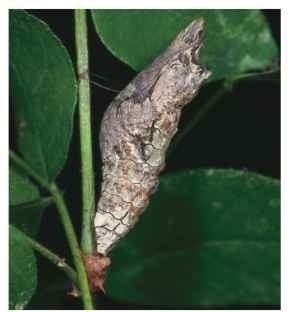Achrysalis (plural chrysalids) is the pupa of a butterfly, usually belonging to the family Papilionidae, Pieridae, or Nymphal-idae. It is commonly found suspended or hanging from a leaf, twig, or branch, or even a windowsill, arbor, or other suitable structure. Not all species in these families form chrysalids. For example, the parnassians in the Papilionidae and the wood nymphs (Satyrinae) in the Nymphalidae pupate in a minimal cocoon in grass, leaves, or litter. The pupae of the families Lycaenidae and Riodinidae are also not suspended and usually are concealed in leaves or litter.
In forming the chrysalis, the prepupal caterpillar has to perform the seemingly impossible maneuver of spinning the silk pad to attach its cremaster (caudal pupal hooks) while maintaining its grip; it then must molt the larval skin as it attaches to the silk pad. Members of the Pieridae and Papilionidae (except Parnassinae) secure the chrysalis in an upright position with a band of silk around the middle (Fig. 1).

FIGURE 1 Pupa of the butterfly Papilio cresphontes showing the strand of silk that holds some butterfly pupae in an upright position.
Chrysalids are usually angular, with projections, tubercles, spines, and sometimes gold or silver flecks. They are often cryptically colored so that they blend into the surrounding materials but some, like the monarch chrysalis, are smooth with gold flecks. In emerging from the chrysalis the adult splits the chrysalis ventrally and dorsally at the anterior end, crawls out, and suspends itself from the pupal skin while its wings expand.
Chrysalis (Insects)
Next post: Chromosomes (Insects)
Previous post: Cicadas (Insects)
